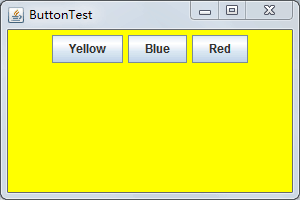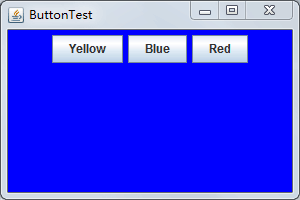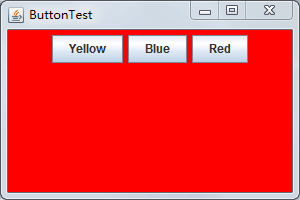201771010125王瑜《面向物件程式設計(Java)》第十三週學習總結
201771010125王瑜《面向物件程式設計(Java)》第十三週學習總結
一.理論部分
1.上週學習了GUI為使用者提供的互動式的圖形化操作介面;AWT包元件,Component元件,Container容器以及Swing元件等;而這周則主要學習到了事件處理,主要知識如下所示:(1)事件處理基礎(2)動作(3)滑鼠事件(4)AWT事件繼承層次
2.事件處理基礎:
(1)事件源:能夠產生事件的物件;一個事件源是一個 能夠註冊監聽器並向監聽器傳送事件物件的物件
(2)事件監聽器:接收事件源傳送的通告並對傳送的事件做出響應;一個監聽器物件就是一個實現了專門監聽器接 口的類例項,該類必須實現介面中的方法,這些方法當 事件發生時,被自動執行
(3)事件物件:Java將事件的相關資訊封裝在一個事件物件中,所有的事件物件都最終派生於java.util.EventObject類;不同的事件源可以產生不 同類別的事件
3.監聽器物件:是一個實現了特定監聽器介面( listener interface)的類例項;事件源:是一個能夠註冊監聽器物件併發送事件對 象的物件;當事件發生時,事件源將事件物件自動傳遞給所 有註冊的監聽器;監聽器物件利用事件物件中的資訊決定如何對事 件做出響應
4.GUI設計中,程式設計師需要對元件的某種事件進行響應和處理時,必須完成兩個步驟:
(1)定義實現某事件監聽器介面的事件監聽器類,並具體化介面中宣告的事件處理抽象方法
(2)為元件註冊實現了規定介面的事件監聽器物件監聽器介面的實現:
5.監聽器類必須實現與事件源相對應的介面,即必 須提供介面中方法的實現
建立按鈕物件 JButton類常用的一組構造方法:
(1) JButton(String text):建立一個帶文字的按扭
(2) JButton(Icon icon) :建立一個帶圖示的按鈕
(3)JButton(String text, Icon icon) :建立一個帶文字和圖示 的按鈕
按鈕物件的常用方法 ① getLabel( ):返回按鈕的標籤字串; ② setLabel(String s):設定按鈕的標籤為字串s
6.動作事件:當特定元件動作(點選按鈕)發生時,該元件生成此動作事件;
(A)該 事 件 被 傳 遞 給 組 件 注 冊 的 每 一 個 ActionListener 物件, 並 調 用 監 聽 器 對 象 的 actionPerformed方法以接收這類事件物件
(B)能夠觸發動作事件的動作,主要包括:
(1)點選按鈕;(2)雙擊一個列表中的選項;(3)選擇選單項;(4)在文字框中輸入回車
7.滑鼠事件:滑鼠監聽器介面;滑鼠監聽器介面卡
使用者點選滑鼠按鈕時,會呼叫三個監聽器方法:
(1) 滑鼠第一次被按下時呼叫mousePressed方法;
(2) 滑鼠被釋放時呼叫mouseReleased方法;
(3)兩個動作完成之後,呼叫mouseClicked方法
8.AWT事件繼承層次:AWT中的事件分類:語義事件以及低層事件
9.(1)所有的事件都是由java.util包中的EventObject 類擴充套件而來
(2)AWTEevent 是所有AWT 事件類的父類, 也是 EventObject的直接子類
(3) 有些Swing元件生成其他型別的事件物件,一般直 接 擴 展 於 EventObject, 而不是AWTEvent,位於 javax.swing.event.*
二.實驗部分:
1、實驗目的與要求
(1) 掌握事件處理的基本原理,理解其用途;
(2) 掌握AWT事件模型的工作機制;
(3) 掌握事件處理的基本程式設計模型;
(4) 瞭解GUI介面元件觀感設定方法;
(5) 掌握WindowAdapter類、AbstractAction類的用法;
(6) 掌握GUI程式中滑鼠事件處理技術。
2、實驗內容和步驟
實驗1: 匯入第11章示例程式,測試程式並進行程式碼註釋。
測試程式1:
l 在elipse IDE中除錯執行教材443頁-444頁程式11-1,結合程式執行結果理解程式;
l 在事件處理相關程式碼處添加註釋;
l 用lambda表示式簡化程式;
l 掌握JButton元件的基本API;
l 掌握Java中事件處理的基本程式設計模型。
package
button;
import
java.awt.*;
import
java.awt.event.*;
import
javax.swing.*;
/**
* A frame with a button panel
*/
public
class
ButtonFrame
extends
JFrame
{
private
JPanel buttonPanel;
private
static
final
int
DEFAULT_WIDTH =
300
;
private
static
final
int
DEFAULT_HEIGHT =
200
;
public
ButtonFrame()
{
//調整元件的大小,寬度和高度
setSize(DEFAULT_WIDTH, DEFAULT_HEIGHT);
// 建立了三個按鈕物件
JButton yellowButton =
new
JButton(
"Yellow"
);
JButton blueButton =
new
JButton(
"Blue"
);
JButton redButton =
new
JButton(
"Red"
);
buttonPanel =
new
JPanel();
// 向面板新增按鈕
buttonPanel.add(yellowButton);
buttonPanel.add(blueButton);
buttonPanel.add(redButton);
//將面板新增到框架
add(buttonPanel);
// 建立按鈕物件
ColorAction yellowAction =
new
ColorAction(Color.YELLOW);
ColorAction blueAction =
new
ColorAction(Color.BLUE);
ColorAction redAction =
new
ColorAction(Color.RED);
// 將動作與按鈕相關聯
yellowButton.addActionListener(yellowAction);
blueButton.addActionListener(blueAction);
redButton.addActionListener(redAction);
}
/**
* An action listener that sets the panel's background color.
*/
private
class
ColorAction
implements
ActionListener
//ColorAction類後面實現了一個監聽器介面類ActionListener
{
private
Color backgroundColor;
//Color 類用於封裝預設 sRGB 顏色空間中的顏色,或者用於封裝由 ColorSpace 標識的任意顏色空間中的顏色
public
ColorAction(Color c)
{
backgroundColor = c;
}
public
void
actionPerformed(ActionEvent event)
{
buttonPanel.setBackground(backgroundColor);
}
}
}
|
?
| 1 2 3 4 5 6 7 8 9 10 11 12 13 14 15 16 17 18 19 20 21 22 23 24 |
package
button;
import
java.awt.*;
import
javax.swing.*;
/**
* @version 1.34 2015-06-12
* @author Cay Horstmann
*/
public
class
ButtonTest
{
public
static
void
main(String[] args)
{
//lambda表示式
EventQueue.invokeLater(() -> {
JFrame frame =
new
ButtonFrame();
frame.setTitle(
"ButtonTest"
);
//setTitle表示將此窗體的標題設定為制定的字串
frame.setDefaultCloseOperation(JFrame.EXIT_ON_CLOSE);
//根據引數的值顯示或隱藏視窗
frame.setVisible(
true
);
});
}
}
|



測試程式2:
l 在elipse IDE中除錯執行教材449頁程式11-2,結合程式執行結果理解程式;
l 在元件觀感設定程式碼處添加註釋;
l 瞭解GUI程式中觀感的設定方法。
| 1 2 3 4 5 6 7 8 9 10 11 12 13 14 15 16 17 18 19 20 21 22 23 24 25 26 27 28 29 30 31 32 33 34 35 36 37 38 39 40 41 42 43 44 45 46 47 48 49 50 51 52 53 54 55 56 57 58 59 60 61 62 63 64 65 66 67 68 69 70 |
package
button;
import
java.awt.*;
import
java.awt.event.*;
import
javax.swing.*;
/**
* A frame with a button panel
*/
public
class
ButtonFrame
extends
JFrame {
private
JPanel buttonPanel;
private
static
final
int
DEFAULT_WIDTH =
300
*
2
;
private
static
final
int
DEFAULT_HEIGHT =
200
*
2
;
public
ButtonFrame() {
setSize(DEFAULT_WIDTH, DEFAULT_HEIGHT);
//用new運算子呼叫構造器
buttonPanel =
new
JPanel();
//建立按鈕生成了三個按鈕物件
makeButton(
"黃色"
, Color.yellow);
makeButton(
"藍色"
, Color.blue);
makeButton(
"紅色"
, Color.red);
makeButton(
"綠色"
,Color.green);
add(buttonPanel);
}
protected
void
makeButton(String name,Color backgound) {
// 建立按鈕
JButton button =
new
JButton(name);
// 向面板新增按鈕
buttonPanel.add(button);
// 建立按鈕操作
//方法一:通過內部類方式實現
/*ColorAction action = new ColorAction(backgound);
// associate actions with buttons
button.addActionListener(action);*/
//方法二:匿名內部類方式實現
button.addActionListener(
new
ActionListener() {
@Override
public
void
actionPerformed(ActionEvent e) {
// TODO 自動生成的方法存根
buttonPanel.setBackground(backgound);
}
});
//方法三通過lambad表示式實現
button.addActionListener((e)->{
buttonPanel.setBackground(backgound);
});
}
/**
* An action listener that sets the panel's background color.
*/
//這是實現了 ActionListener介面的內部類
/*private class ColorAction implements ActionListener {
//實現了標準介面:監聽器介面,類名是ColorAction
private Color backgroundColor;
public ColorAction(Color c) {
backgroundColor = c;
}
public void actionPerformed(ActionEvent event) {
buttonPanel.setBackground(backgroundColor);
}
}*/
}
|
執行結果:

測試程式3:
l 在elipse IDE中除錯執行教材457頁-458頁程式11-3,結合程式執行結果理解程式;
l 掌握AbstractAction類及其動作物件;
l 掌握GUI程式中按鈕、鍵盤動作對映到動作物件的方法。
| 1 2 3 4 5 6 7 8 9 10 11 12 13 14 15 16 17 18 19 20 21 22 23 24 25 26 27 28 29 30 31 32 33 34 35 36 37 38 39 40 41 42 43 44 45 46 47 48 49 50 51 52 53 54 55 56 57 58 59 60 61 62 63 64 65 66 67 68 69 70 71 72 73 74 75 76 77 |
package
action;
import
java.awt.*;
import
java.awt.event.*;
import
javax.swing.*;
/**
* A frame with a panel that demonstrates color change actions.
*/
public
class
ActionFrame
extends
JFrame
{
//JPanel是一般輕量級容器
private
JPanel buttonPanel;
private
static
final
int
DEFAULT_WIDTH =
300
;
private
static
final
int
DEFAULT_HEIGHT =
200
;
public
ActionFrame()
{
setSize(DEFAULT_WIDTH, DEFAULT_HEIGHT);
buttonPanel =
new
JPanel();
//定義動作
Action yellowAction =
new
ColorAction(
"Yellow"
,
new
ImageIcon(
"yellow-ball.gif"
),
Color.YELLOW);
Action blueAction =
new
ColorAction(
"Blue"
,
new
ImageIcon(
"blue-ball.gif"
), Color.BLUE);
Action redAction =
new
ColorAction(
"Red"
,
new
ImageIcon(
"red-ball.gif"
), Color.RED);
// 新增這些操作的按鈕
buttonPanel.add(
new
JButton(yellowAction));
buttonPanel.add(
new
JButton(blueAction));
buttonPanel.add(
new
JButton(redAction));
// 將面板新增到框
add(buttonPanel);
// 將y b和r鍵與名稱相關聯
InputMap imap = buttonPanel.getInputMap(JComponent.WHEN_ANCESTOR_OF_FOCUSED_COMPONENT);
imap.put(KeyStroke.getKeyStroke(
"ctrl Y"
),
"panel.yellow"
);
imap.put(KeyStroke.getKeyStroke(
"ctrl B"
),
"panel.blue"
);
imap.put(KeyStroke.getKeyStroke(
"ctrl R"
),
"panel.red"
);
// 將名稱與操作相關聯
ActionMap amap = buttonPanel.getActionMap();
//ActionMap 提供從 Object(稱為鍵 或 Action 名)到 Action 的對映
amap.put(
"panel.yellow"
, yellowAction);
//put:新增一個 key 到 action 的繫結
amap.put(
"panel.blue"
, blueAction);
amap.put(
"panel.red"
, redAction);
}
public
class
ColorAction
extends
AbstractAction
//ColorAction類介面實現了AbstractAction介面的繼承
{
/**
* Constructs a color action.
* @param name the name to show on the button
* @param icon the icon to display on the button
* @param c the background color
*/
public
ColorAction(String name, Icon icon, Color c)
{
putValue(Action.NAME, name);
//NAME用來儲存動作的 String 名稱的鍵,用於選單或按鈕。
putValue(Action.SMALL_ICON, icon);
//用來儲存小型 Icon(比如 ImageIcon)的鍵
putValue(Action.SHORT_DESCRIPTION,
"Set panel color to "
+ name.toLowerCase());
putValue(
"color"
, c);
}
//指
|
